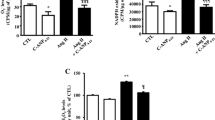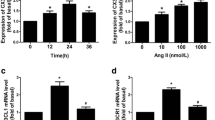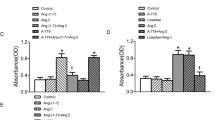Abstract
Excessive proliferation of vascular smooth cells (VSMCs) plays a critical role in the pathogenesis of diverse vascular disorders, and inhibition of VSMCs proliferation has been proved to be beneficial to these diseases. In this study, we investigated the antiproliferative effect of B-type natriuretic peptide (BNP), a natriuretic peptide with potent antioxidant capacity, on rat aortic VSMCs, and the possible mechanisms involved. The results indicate that BNP potently inhibited AngiotensinII (AngII)-induced VSMCs proliferation, as evaluated by [3H]-thymidine incorporation assay. Consistently, BNP significantly decreased AngII-induced intracellular reactive oxygen species (ROS) and NAD(P)H oxidase activity. 8-Br-cGMP, a cGMP analog, mimicked these effects. To confirm its mechanism, siRNA of natriuretic peptide receptor-A(NRPA) strategy technology was used to block cGMP production in VSMCs, and siNPRA attenuated the inhibitory effects of BNP in VSMCs. Taken together, these results indicate that BNP was capable of inhibiting VSMCs proliferation by NPRA/cGMP pathway, which might be associated with the suppression of ROS production. These results might be related, at least partly, to the anti-oxidant property of BNP.






Similar content being viewed by others
References
Ross R (1999) Atheroslcerosis—an inflammatory disease. N Engl J Med 340:115–126. doi:10.1056/NEJM199901143400207
da-Cunha V, Tham DM, Martin-McNulty B, Deng G, Ho JJ, Wilson DW, Rutledge JC, Vergona R, Sullivan ME, Wang YX (2005) Enalapril attenuates angiotensin II-induced atherosclerosis and vascular inflammation. Atherosclerosis 178:9–17. doi:10.1016/j.atherosclerosis.2004.08.023
Daugherty A, Rateri DL, Lu H, Inagami T, Cassis LA (2004) Hypercholesterolemia stimulates angiotensin peptide synthesis and contributes to atherosclerosis through the AT1A receptor. Circulation 110:3849–3857. doi:10.1161/01.CIR.0000150540.54220.C4
Rosenkranz AC, Woods RL, Dusting GJ, Ritchie RH (2003) Antihypertrophic actions of the natriuretic peptides in adult rat cardiomyocytes: importance of cyclic GMP. Cardiovasc Res 57:515–522. doi:10.1016/S0008-6363(02)00667-3
Rosenkranz AC, Hood SG, Woods RL, Dusting GJ, Ritchie RH (2003) B type natriuretic peptide prevents acute hypertrophic responses in the diabetic rat heart: importance of cyclic GMP. Diabetes 52:2389–2395. doi:10.2337/diabetes.52.9.2389
Horio T, Nishikimi T, Yoshihara F, Matsuo H, Takishita S, Kangawa K (2000) Inhibitory regulation of hypertrophy by endogenous atrial natriuretic peptide in cultured cardiac myocytes. Hypertension 35:19–24
Tremblay J, Desjardins R, Hum D, Gutkowska J, Hamet P (2002) Biochemistry and physiology of the natriuretic peptide receptor guanylyl cyclases. Mol Cell Biochem 230:31–47. doi:10.1023/A:1014260204524
Anand-Srivastava MB, Trachte GJ (1993) Atrial natriuretic factor receptors and signal transduction mechanisms. Pharmacol Rev 45:455–497
Anand-Srivastava MB, Srivastava AK, Cantin M (1987) Pertussis toxin attenuates atrial natriuretic factor-mediated inhibition of adenylate cyclase. Involvement of inhibitory guanine nucleotide regulatory protein. J Biol Chem 262:4931–4934
Anand-Srivastava MB, Sairam MR, Cantin M (1990) Ring-deleted analogs of atrial natriuretic factor inhibit adenylate cyclase/cAMP system. Possible coupling of clearance atrial natriuretic factor receptors to adenylate cyclase/cAMP signal transduction system. J Biol Chem 265:8566–8572
Hirata M, Chang CH, Murad F (1989) Stimulatory effects of atrial natriuretic factor on phosphoinositide hydrolysis in cultured bovine aortic smooth muscle cells. Biochim Biophys Acta 1010:346–351. doi:10.1016/0167-4889(89)90060-8
Oliver PM, Fox JE, Kim R, Rockman HA, Kim HS, Reddick RL, Pandey KN, Milgram SL, Smithies O, Maeda N (1997) Hypertension, cardiac hypertrophy and sudden death in mice lacking natriuretic peptide receptor A. Proc Natl Acad Sci USA 94:14730–14735. doi:10.1073/pnas.94.26.14730
Kishimoto I, Rossi K, Garber DL (2001) A genetic model provides evidence for the receptor for atrial natriuretic peptide (guanylyl cyclase A) inhibits cardiac hypertrophy. Proc Natl Acad Sci USA 98:2703–2706. doi:10.1073/pnas.051625598
Baldini PM, De Vito P, Fraziano M, Mattioli P, Luly P, Di Nardo P (2002) Atrial natriuretic factor inhibits mitogen-induced growth in rat aortic smooth muscle cells. J Cell Physiol 193:103–109. doi:10.1002/jcp.10155
Prins BA, Weber MJ, Hu RM, Pedram A, Daniels M, Levin ER (1996) Atrial natriuretic peptide inhibits mitogen-activated protein kinase through the clearance receptor. J Biol Chem 271:14156–14162. doi:10.1074/jbc.271.24.14156
Levin ER, Frank HJL (1991) Natriuretic peptides inhibit rat astroglial proliferation. Mediation by C receptor. Am J Physiol 261:453–457
Ide T, Tsutsui H, Kinugawa S, Suematsu N, Hayashidani S, Ichikawa K et al (2000) Direct evidence for increased hydroxyl radicals originating from superoxide in the failing myocardium. Circ Res 86:152–157
Date MO, Morita T, Yamashita N, Nishida K, Yamaguchi O, Higuchi Y, Hirotani S, Matsumura S, Hori M, Tada M (2002) The antioxidant N-2-mercaptopropionyl glycine attenuates left ventricular hypertrophy in in vivo murine pressure-overload model. J Am Coll Cardiol 39:907–912. doi:10.1016/S0735-1097(01)01826-5
Rocic P, Seshiah P, Griendling KK (2003) Reactive oxygen species sensitivity of angiotensin II-dependent translation initiation in vascular smooth muscle cells. J Biol Chem 278:36973–36979. doi:10.1074/jbc.M302099200
Baldini PM, De Vito P, D′aquilio F, Vismara D, Zalfa F, Bagni C, Fiaccavento R, Di-Nardo P (2005) Role of atrial natriuretic peptide in the suppression of lysophosphatydic acid-induced rat aortic smooth muscle (RASM) cell growth. Mol Cell Biochem 272:19–28. doi:10.1007/s11010-005-4779-0
Ross R (1971) The smooth muscle cell. II. Growth of muscle in culture and formation of elastic fibers. J Cell Biol 50:172–186. doi:10.1083/jcb.50.1.172
Kong X, Wang X, Xu W, Behera S, Hellermann G, Kumar A, Lockey RF, Mohapatra S, Mohapatra SS (2008) Natriuretic peptide receptor a as a novel anticancer target. Cancer Res 68:249–256. doi:10.1158/0008-5472.CAN-07-3086
Moriyama N, Taniguchi M, Miyano K, Miyoshi M, Watanabe T (2006) ANP inhibits LPS-induced stimulation of rat microglial cells by suppressing NF-κB and AP-1 activations. Biochem Biophys Res Commun 350:322–328. doi:10.1016/j.bbrc.2006.09.034
Kapoun AM, Liang F, O′Young G, Damm DL, Quon D, White RT, Munson K, Lam A, Schreiner GF, Protter AA (2004) B-Type Natriuretic Peptide Exerts Broad Functional Opposition to Transforming Growth Factor-β in Primary Human Cardiac Fibroblasts: fibrosis, myofibroblast conversion, proliferation, and inflammation. Circ Res 94:453–461. doi:10.1161/01.RES.0000117070.86556.9F
Harris EL, Grigor MR, Millar JA (1990) Differences in mitogenic responses to angiotensin II, calf serum and phorbol ester in vascular smooth muscle cells from two strains of genetically hypertensive rat. Biochem Biophys Res Commun 170:1249–1255. doi:10.1016/0006-291X(90)90528-U
Shen HM, Shi CY, Shen Y, Ong CN (1996) Detection of elevated reactive oxygen species level in cultured rat hepatocytes treated with aflatoxin B1. Free Radic Biol Med 21:139–146. doi:10.1016/0891-5849(96)00019-6
Szöcs K, Lassègue B, Wenzel P, Wendt M, Daiber A, Oelze M et al (2007) Increased superoxide production in nitrate tolerance is associated with NAD(P)H oxidase and aldehyde dehydrogenase 2 downregulation. J Mol Cell Cardiol 42:1111–1118. doi:10.1016/j.yjmcc.2007.03.904
Laskowski A, Woodman OL, Cao AH, Drummond GR, Marshall T, Kaye DM, Ritchie RH (2006) Antioxidant actions contribute to the antihypertrophic effects of atrial natriuretic peptide in neonatal rat cardiomyocytes. Cardiovasc Res 72:112–123. doi:10.1016/j.cardiores.2006.07.006
Viedt C, Soto U, Krieger-Brauer HI, Fei J, Elsing C, Kübler W, Kreuzer J (2000) Differential activation of mitogen-activated protein kinases in smooth muscle cells by angiotensin II: involvement of p22phox and reactive oxygen species. Arterioscler Thromb Vasc Biol 20:940–948
Sun JJ, Kim HJ, Seo HG, Lee JH, Yun-Choi HS, Chang KC (2008) YS 49, 1-(alpha-naphtylmethyl)-6, 7-dihydroxy-1, 2, 3, 4-tetrahydroisoquinoline, regulates angiotensin II-stimulated ROS production, JNK phosphorylation and vascular smooth muscle cell proliferation via the induction of heme oxygenase-1. Life Sci 82:600–607
Shaw S, Wang X, Redd H, Alexander GD, Isales CM, Marrero MB (2003) High glucose augments the angiotensin II-induced activation of JAK2 in vascular smooth muscle cells via the polyol pathway. J Biol Chem 278:30634–30641. doi:10.1074/jbc.M305008200
Vendrov AE, Hakim ZS, Madamanchi NR, Rojas M, Madamanchi C, Runge MS (2007) Atherosclerosis is attenuated by limiting superoxide generation in both macrophages and vessel wall cells. Arterioscler Thromb Vasc Biol 27:2714–2721. doi:10.01161/ATVBAHA.107.152629
Touyz RM, Yao G, Quinn MT, Pagano PJ, Schiffrin EL (2005) p47phox associates with the cytoskeleton through cortactin in human vascular smooth muscle cells: role in NAD(P)H oxidase regulation by angiotensin II. Arterioscler Thromb Vasc Biol 25:512–518. doi:10.1161/01.ATV.0000154141.66879.98
Taniyama Y, Ushio-Fukai M, Hitomi H, Rocic P, Kingsley MJ, Pfahnl C, Weber DS, Alexander RW, Griendling KK (2004) Role of p38 MAPK and MAPKAPK-2 in angiotensin II-induced Akt activation in vascular smooth muscle cells. Am J Physiol Cell Physiol 287:C494–C499. doi:10.1152/ajpcell.00439.2003
Gorin Y, Ricono JM, Wagner B, Kim NH, Bhandari B, Choudhury GG, Abboud HE (2004) Angiotensin II-induced ERK1/2 activation and protein synthesis are redox-dependent in glomerular mesangial cells. Biochem J 381:231–239. doi:10.1042/BJ20031614
Lin FY, Chen YH, Tasi JS, Chen JW, Yang TL, Wang HJ, Li CY, Chen YL, Lin SJ (2006) Endotoxin induces toll-like receptor 4 expression in vascular smooth muscle cells via NADPH oxidase activation and mitogen-activated protein kinase signaling pathways. Arterioscler Thromb Vasc Biol 26:2630–2637. doi:10.1161/01.ATV.0000247259.01257.b3
Lee HS, Son SM, Kim YK, Hong KW, Kim CD (2003) NAD(P)H oxidase participates in the signaling events in high glucose-induced proliferation of vascular smooth muscle cells. Life Sci 72:2719–2730. doi:10.1016/S0024-3205(03)00186-3
Bilzer M, Jaeschke H, Vollmar AM, Paumgartner C, Gerbers AL (1999) Prevention of Kupffer cell-induced oxidant injury in rat liver by atrial natriuretic peptide. Am J Physiol 276:1137–1144
De Vito P, Di Nardo P, Palmery M, Peluso I, Luly P, Baldini PM (2003) Oxidant-induced pHi/Ca2+ changes in rat aortic smooth muscle cells. The role of atrial natriuretic peptide. Mol Cell Biochem 252:353–362. doi:10.1023/A:1025508828271
Carini R, De Cesaris MG, Splendore R, Domenicotti C, Nitti MP, Pronzato MA, Albano E (2003) Mechanism of hepatocyte protection against hypoxic injury by atrial natriuretic peptide. Hepatology 37:277–285. doi:10.1053/jhep.2003.50033
Baldini PM, De Vito P, Martino A, Fraziano M, Grimaldi C, Luly P, Zalfa F, Colizzi V (2003) Differential sensitivity of human monocytes and macrophages to ANP: a role of intracellular pH on reactive oxygen species production through the phospholipase involvement. J Leukoc Biol 73:502–510. doi:10.1189/jlb.0702377
Acknowledgments
The authors would like to thank Hua-li Kang and Meng-yang Deng for their excellent technical assistance.
Author information
Authors and Affiliations
Corresponding author
Rights and permissions
About this article
Cite this article
Gao, P., Qian, DH., Li, W. et al. NPRA-mediated suppression of AngII-induced ROS production contribute to the antiproliferative effects of B-type natriuretic peptide in VSMC. Mol Cell Biochem 324, 165–172 (2009). https://doi.org/10.1007/s11010-008-9995-y
Received:
Accepted:
Published:
Issue Date:
DOI: https://doi.org/10.1007/s11010-008-9995-y




